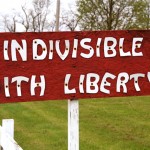
My heart was racing when my wife told me the story of my daughter explaining how God is in her school everyday and that he’s invisible. She said they talk about it each day when they look at the flag. I instantly thought, “Oh my, her teacher is telling them they can think about God during a moment of silence.” I’m not against worship, but I think school is a safe zone for this kind of thing. Turns out my fears were for naught and my apologies go out to Mrs. M., whom I’ve not even met yet.
No, no. My daughter was speaking of the God of:
I pledge allegiance to the Flag of the United States of America, and to the Republic for which it stands, one Nation under God, indivisible, with liberty and justice for all.
Her God just happens to be invisible, not indivisible. She’s still right.

